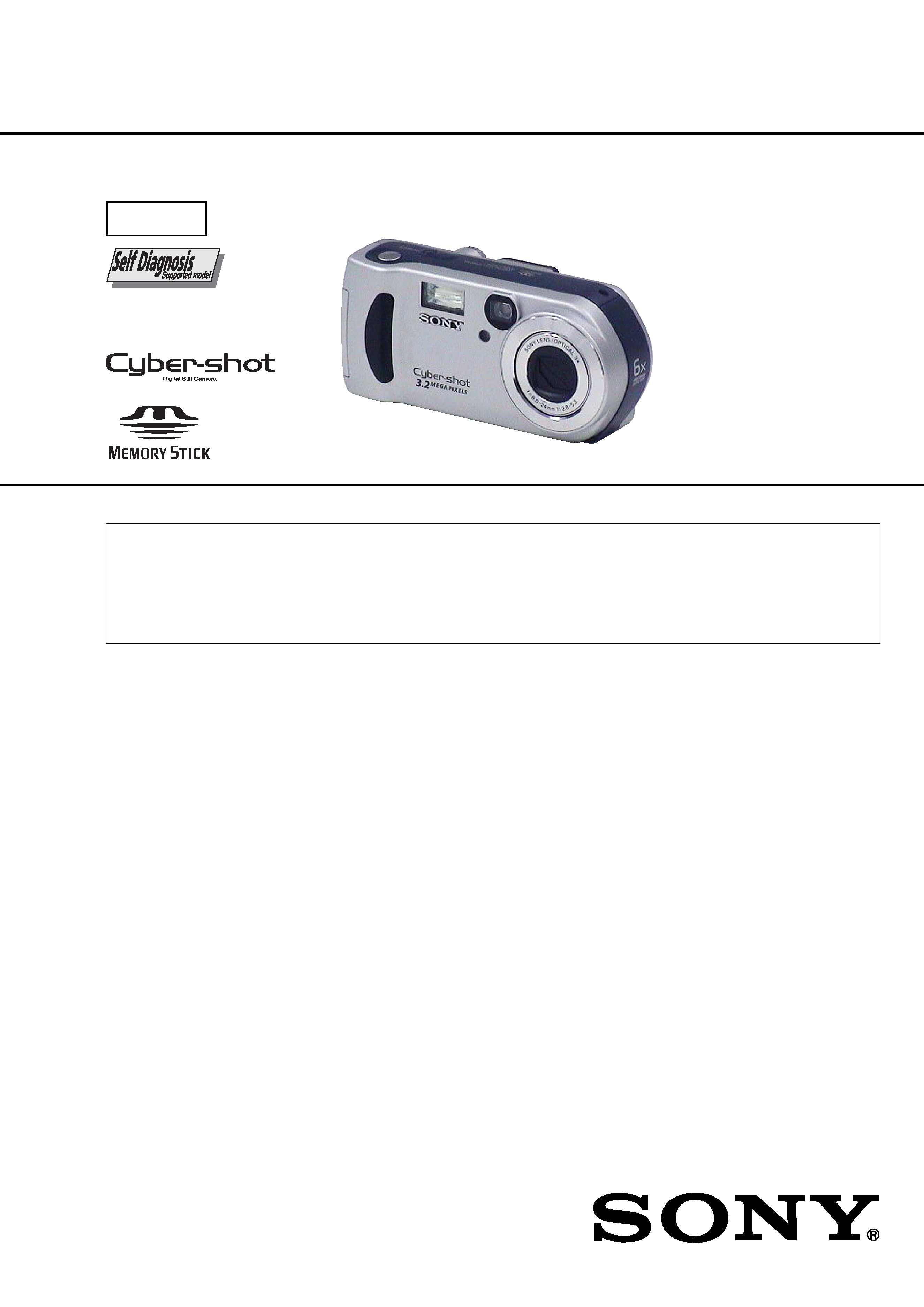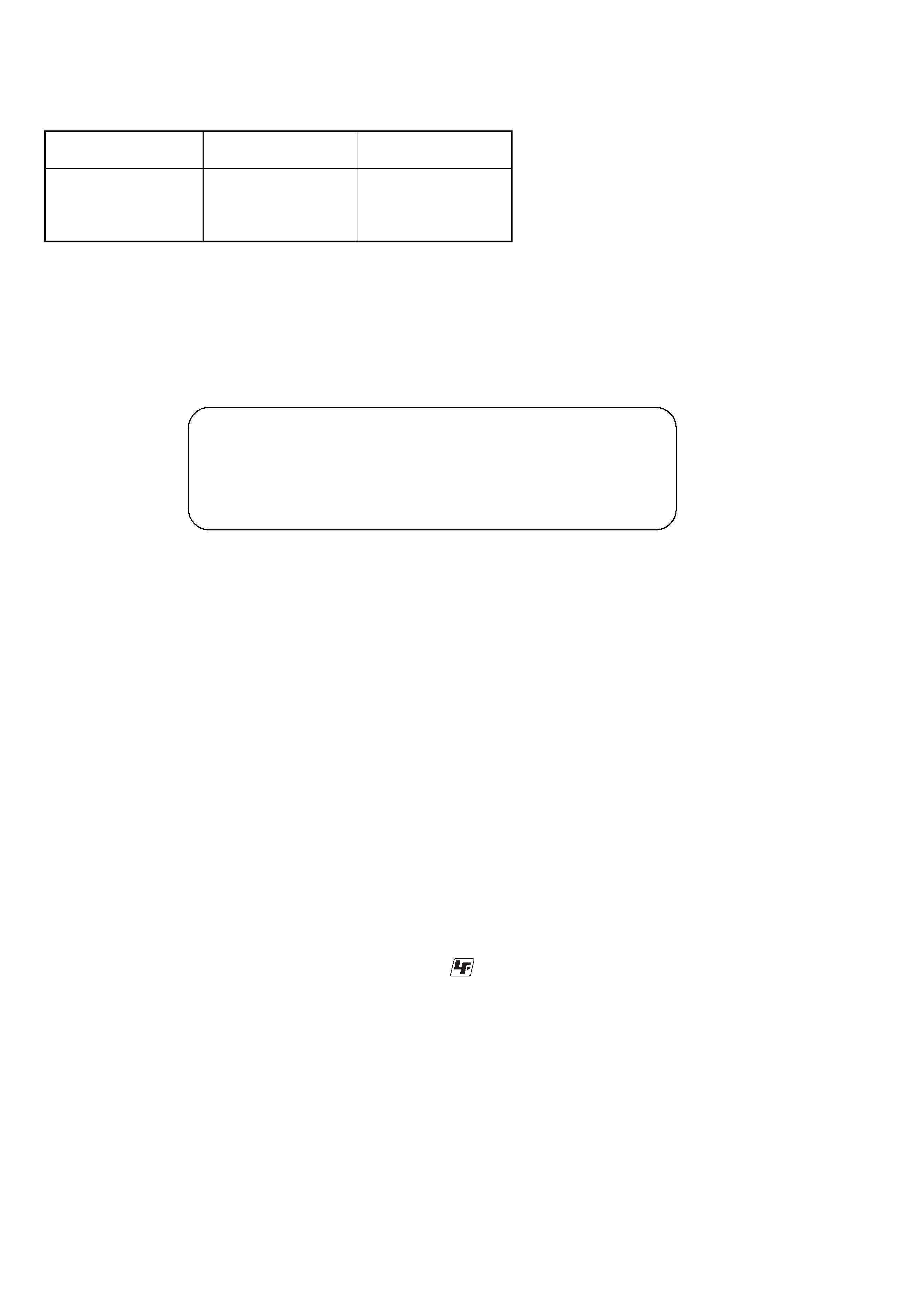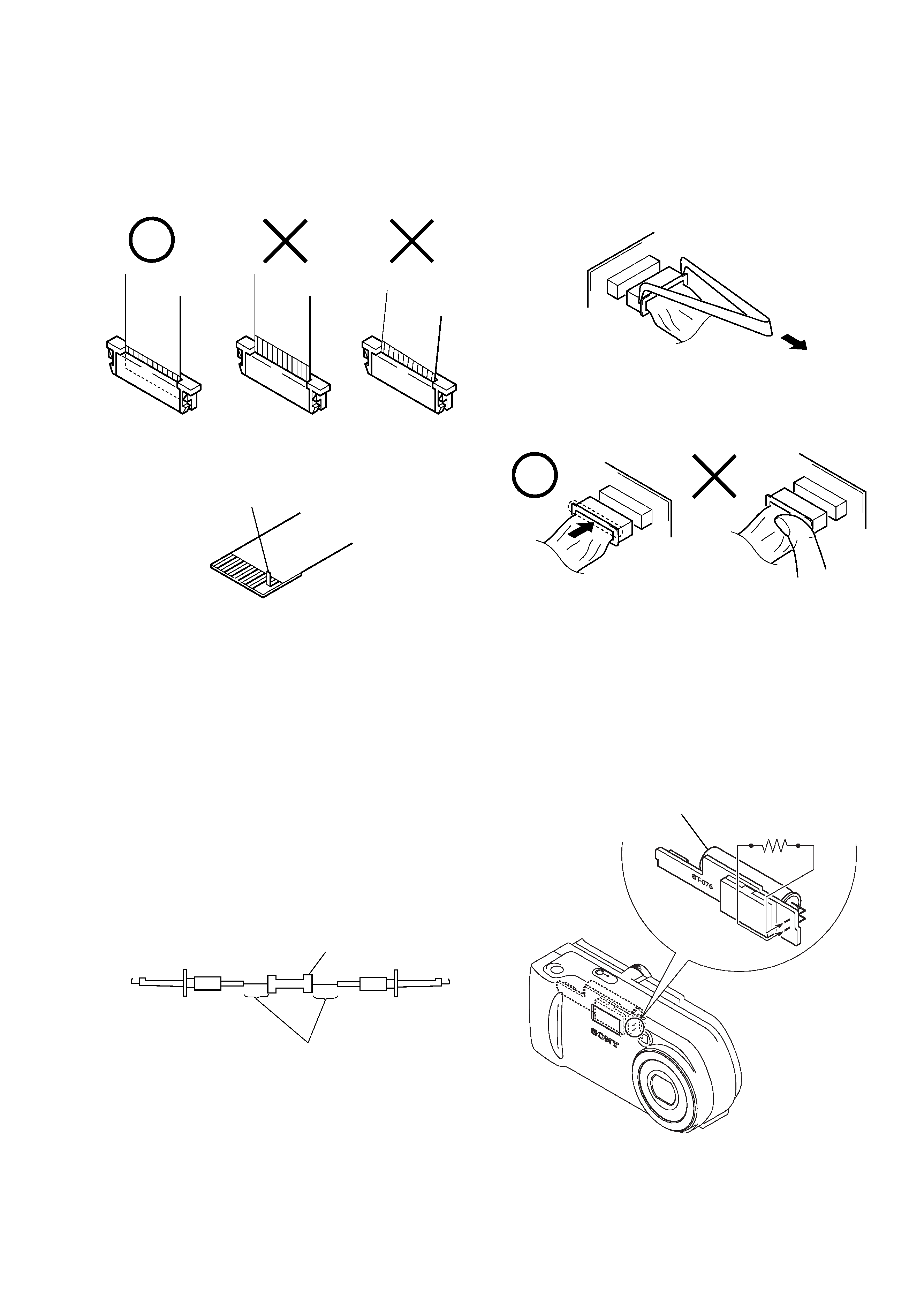
SERVICE MANUAL
DIGITAL STILL CAMERA
Level 2
SPECIFICATIONS
Ver 1.1 2002. 04
DSC-P71/P71M
System
Image device 8.93mm (1/1.8 type) color
CCD
Primary color filter
Effective pixels number of camera
Approx. 3 210 000 pixels
Lens
3
× zoom lens
f=8~24.0 mm (35 mm camera
conversion: 39 to 117mm)
F2.8~5.3
Exposure control
Automatic,
Scene Selection (3 mode)
White balanceAutomatic, Daylight, Cloudy,
Fluorescent, Incandescent
Data formats Moving images: MPEG1
Still images: JPEG, GIFF (for Clip
Motion)
Recording media
"Memory Stick"
Flash
Recommended distance
0.5 to 3.8 m (1.6 to 12.5 ft) (W)
0.5 to 2.5 m (1.6 to 8.2 ft) (T)
(when ISO sensitivity is set to Auto)
Output connectors
VIDEO OUT jack
Minijack
1 Vp-p, 75 ohm, unbalanced, sync
negative
USB jack
mini-B
LCD screen
LCD panel used
3.8 cm (1.5 type) TFT drive
Total number of dots
123 200 (560x220) dots
Power, etc.
Power
AA nickel hydride batteries (2)
2.4 V
AC-LS1 AC power adaptor
(not supplied), 4.2 V
Power consumption (when recording)
2.1W
Operating temperature range
0
° to +40°C (32° to +104°F)
Storage temperature range
-20
° to +60°C (-4° to +140°F)
Dimensions
124.9
× 58 × 43.6 mm (5 × 2
3/
8
1 3/4 inches)
(W/H/D, protruding portions not
included)
Mass
284 g (10 oz) (camera, two batteries,
"Memory Stick" and wrist strap
included)
BC-CS1 Ni-MH battery charger
Power requirements
AC 100 to 240V 50/60Hz
2.2 W
Output voltage
DC 1.8V 180/110 mA
2
Dimensions
70
× 29 × 74 mm (2
7/
8 × 1
3/
16 × 3
inches) (W/H/D)
Mass
Approx. 70g (2 oz)
Operating temperature range
0
° to +40°C (32° to +104°F)
AC-LS1 AC power adaptor (not
supplied)
Power requirements
AC 100 240 V, 50/60 Hz
Rated output voltage
DC 4.2 V, 1.5 A
External dimensions
105
× 36 × 56 mm (4
1/
4 ×
×
1 7/16
2 1/4)(W/H/D, protruding parts not
included)
Mass
Approx. 180 g (6 oz)
(adaptor only)
Operating temperature range
0
° to +40°C (32° to +104°F)
Storage temperature range
-20
° to +60°C (-4° to +140°F)
Accessories
· Video connector cable (1)
· R6 (size AA) Ni-MH batteries (2)
· Ni-MH Battery charger (1)
· Power cord (mains lead) (1)
· USB cable (1)
· Wrist strap
· "Memory Stick" (16MB) (1)
· CD-ROM (USB driver: SPVD-008) (1)
· CD-ROM (for Customer registration) (1)
· Operation Instructions (1)
Design and specifications are subject to change
without notice.
×
This service manual contains information for Japanese model as well.
On the SY-075 board
This service manual procides the information that is premised the
circuit board replacement service and not intended repair inside the
SY-075 board.
Therefore, schematic diagram, printed wiring board and electrical
parts list of the SY-075 board are not shown.
The following pages are not shown.
SY-075 board
Schematic diagram ................................... Pages 4-11 to 4-26
Printed wiring board ................................. Pages 4-43 to 4-46
Electrical parts list .................................... Pages 6-4 to 6-11
The above-described information is shown in service manual
Level 3.
US Model
DSC-P71/P71M
Canadian Model
AEP Model
UK Model
E Model
Hong Kong Model
Australian Model
Chinese Model
Korea Model
Tourist Model
Japanese Model
DSC-P71

2
DSC-P71/P71M
1. Check the area of your repair for unsoldered or poorly-sol-
dered connections. Check the entire board surface for solder
splashes and bridges.
2. Check the interboard wiring to ensure that no wires are
"pinched" or contact high-wattage resistors.
3. Look for unauthorized replacement parts, particularly transis-
tors, that were installed during a previous repair. Point them
out to the customer and recommend their replacement.
4. Look for parts which, though functioning, show obvious signs
of deterioration. Point them out to the customer and recom-
mend their replacement.
5. Check the B+ voltage to see it is at the values specified.
6. Flexible Circuit Board Repairing
·Keep the temperature of the soldering iron around 270 °C
during repairing.
·
Do not touch the soldering iron on the same conductor of
the circuit board (within 3 times).
·
Be careful not to apply force on the conductor when sol-
dering or unsoldering.
SAFETY CHECK-OUT
After correcting the original service problem, perform the following
safety checks before releasing the set to the customer.
ATTENTION AU COMPOSANT AYANT RAPPORT
À LA SÉCURITÉ!
LES COMPOSANTS IDENTIFIÉS PAR UNE MARQUE 0
SUR LES DIAGRAMMES SCHÉMATIQUES ET LA LISTE
DES PIÈCES SONT CRITIQUES POUR LA SÉCURITÉ
DE FONCTIONNEMENT. NE REMPLACER CES COM-
POSANTS QUE PAR DES PIÈCES SONY DONT LES
NUMÉROS SONT DONNÉS DANS CE MANUEL OU
DANS LES SUPPLÉMENTS PUBLIÉS PAR SONY.
SAFETY-RELATED COMPONENT WARNING!!
COMPONENTS IDENTIFIED BY MARK 0 OR DOTTED
LINE WITH MARK 0 ON THE SCHEMATIC DIAGRAMS
AND IN THE PARTS LIST ARE CRITICAL TO SAFE
OPERATION. REPLACE THESE COMPONENTS WITH
SONY PARTS WHOSE PART NUMBERS APPEAR AS
SHOWN IN THIS MANUAL OR IN SUPPLEMENTS PUB-
LISHED BY SONY.
UNLEADED SOLDER
Boards requiring use of unleaded solder are printed with the lead-
free mark (LF) indicating the solder contains no lead.
(Caution: Some printed circuit boards may not come printed with
the lead free mark due to their particular size)
: LEAD FREE MARK
Unleaded solder has the following characteristics.
· Unleaded solder melts at a temperature about 40 °C higher than
ordinary solder.
Ordinary soldering irons can be used but the iron tip has to be
applied to the solder joint for a slightly longer time.
Soldering irons using a temperature regulator should be set to
about 350 °C .
Caution: The printed pattern (copper foil) may peel away if the
heated tip is applied for too long, so be careful!
· Strong viscosity
Unleaded solder is more viscous (sticky, less prone to flow) than
ordinary solder so use caution not to let solder bridges occur
such as on IC pins, etc.
· Usable with ordinary solder
It is best to use only unleaded solder but unleaded solder may
also be added to ordinary solder.
CAUTION
Use of controls or adjustments or perfor mance
procedures other than those specified herein may
result in hazardous radiation exposure.
Table for differences of function
Model
DSC-P71
DSC-P71M
(Note)
Destination
US, Canadian, AEP, UK
US
E, J, Hong Kong,
Australian, Chinese,
Korea, Tourist
Note: DSC-P71M is the same as DSC-P71 (US model) except packing materials.
Therefore, information about DSC-P71 (US model) in the text is applied.

3
DSC-P71/P71M
SERVICE NOTE ................................................................... 5
Self-diagnosis Display .......................................................... 6
1.
GENERAL
Before using your camera ....................................................... 1-2
Identifying the Parts ................................................................. 1-4
Preparing batteries .................................................................. 1-5
Charging the batteries ............................................................. 1-5
Inserting the batteries ............................................................. 1-6
Using an external power source ............................................. 1-7
Using your camera abroad ...................................................... 1-7
Turning on/off your camera ..................................................... 1-8
How to use the control button ................................................. 1-8
Setting the data and time ........................................................ 1-8
Inserting and removing a "Memory Stick" ............................... 1-9
Deciding the still image size and image quality ...................... 1-10
Basic still image shooting (using auto adjustment mode) ...... 1-11
Viewing images on the LCD screen of your camera .............. 1-16
Viewing images on a TV screen .............................................. 1-17
Deleting still images ................................................................ 1-17
Formatting a "Memory Stick" ................................................... 1-19
Copying still images to your Computer ................................... 1-20
Installing the USB driver .......................................................... 1-20
Preparing your camera ............................................................ 1-21
Connecting your camera to your computer ............................. 1-21
Copying images ....................................................................... 1-22
Viewing the images on your computer .................................... 1-24
For Macintosh users ................................................................ 1-25
How to setup and operate your camera .................................. 1-25
Troubleshooting ....................................................................... 1-39
Warning and Messages ........................................................... 1-42
Self-diagnostics Display .......................................................... 1-43
Menu items .............................................................................. 1-44
SET UP items .......................................................................... 1-46
The LCD screen ...................................................................... 1-48
2.
DISASSEMBLY
2-1.
Cabinet (Rear) Block Assembly .................................... 2-2
2-2.
PK-064 Board ................................................................ 2-2
2-3.
LCD Module ................................................................... 2-3
2-4.
Cabinet (Front) Block Assembly .................................... 2-3
2-5.
Cabinet (Upper) Block Assembly .................................. 2-4
2-6.
ST-075 Board ................................................................. 2-4
2-7.
Lens Block Assembly .................................................... 2-5
2-8.
Memory Stick Connector ............................................... 2-5
2-9.
CD-392 Board ............................................................... 2-6
2-10. JK-231 Board ................................................................ 2-6
2-11. SY-075 Board ................................................................ 2-7
Service Position (SY-075 Board: Side B) ...................... 2-7
Service Position (SY-075 Board: Side A) ...................... 2-8
2-12. Circuit Boards Location ................................................. 2-9
2-13. Flexible Board Location ................................................. 2-10
3.
BLOCK DIAGRAMS
3-1.
Overall Block Diagram .................................................. 3-1
3-7.
Power Block Diagram 1 ................................................. 3-13
3-8.
Power Block Diagram 2 ................................................. 3-15
TABLE OF CONTENTS
Section
Title
Page
Section
Title
Page
4.
PRINTED WIRING BOARDS AND
SCHEMATIC DIAGRAMS
4-1.
Frame Schematic Diagrams .......................................... 4-1
Frame Schematic Diagram (1/2) ................................... 4-1
Frame Schematic Diagram (2/2) ................................... 4-3
4-2.
Schematic Diagrams ..................................................... 4-5
CD-392 (CCD IMAGER) ............................................... 4-7
CH-109 (CAMERA PROCESS) .................................... 4-9
PK-064 (1/3) (FRONT CONTROL) ............................... 4-27
PK-064 (2/3) (LCD DRIVE, TIMING GENERATOR) ..... 4-29
PK-064 (3/3) (CONTROL SWITCH) ............................. 4-31
JK-231 (JACK) ............................................................... 4-32
ST-075 (FLASH DRIVE) ................................................ 4-33
4-3.
Printed Wiring Boards ................................................... 4-37
CD-392 .......................................................................... 4-39
CH-109 .......................................................................... 4-41
PK-064 ........................................................................... 4-47
JK-231 ........................................................................... 4-51
ST-075 ........................................................................... 4-53
4-4.
Waveforms ..................................................................... 4-57
4-5.
Parts Location ............................................................... 4-61
5.
ADJUSTMENTS
1-1.
Adjusting Items when Replacing
Main Parts and Boards .................................................. 5-2
5-1.
Camera Section Adjustments ........................................ 5-3
1-1.
Preparations Before Adjustment ................................... 5-3
1-1-1. List of Service Tools ................................................. 5-3
1-1-2. Preparations ............................................................. 5-4
1-1-3. Discharging of the Flashlight Power Supply ............ 5-4
1-1-4. Precautions .............................................................. 5-6
1. Setting the Switch .................................................... 5-6
2. Order of Adjustments ............................................... 5-6
3. Subjects .................................................................... 5-6
4. Preparing the Flash Adjustment Box ....................... 5-7
1-2.
Initialization of A, B, D, E, F, 7, 9 Page Data ................ 5-8
1-2-1. Initialization of A, D Page Data ................................ 5-8
1. Initializing A, D Page Data ....................................... 5-8
2. Modification of A, D Page Data ................................ 5-8
3. A Page Table ............................................................ 5-8
4. D Page Table ............................................................ 5-8
1-2-2. Initialization of B, E, F, 7, 9 Page Data .................... 5-9
1. Initializing B, E, F, 7, 9 Page Data ........................... 5-9
2. Modification of B, E, F, 7, 9 Page Data. ................... 5-9
3. B Page Table ............................................................ 5-9
4. E Page Table ............................................................ 5-9
5. F Page Table ............................................................. 5-10
6. 7 Page Table ............................................................. 5-11
7. 9 Page Table ............................................................. 5-11
1-3.
Video System Adjustment ............................................. 5-12
1.
Composite Video Level Adjustment .............................. 5-12
1-4.
Camera System Adjustments ....................................... 5-13
Data Setting During Camera System Adjustments .............. 5-13
Picture Frame Setting ........................................................... 5-14
Check on the Oscilloscope ................................................... 5-14
1.
Flange Back Adjustment
(Using the minipattern box) ........................................... 5-15
2.
Flange Back Adjustment
(Using the flange back adjustment chart
and Subject More than 500 m Away) ............................ 5-16
3.
Flange Back Check ....................................................... 5-17
4.
F No. Compensation ...................................................... 5-18
5.
Mechanical Shutter Adjustment .................................... 5-18
6.
Light Value Adjustment ................................................. 5-19
7.
Mixed Color Cancel Adjustment .................................... 5-19
8.
Auto White Balance 3200K Standard Data Input ......... 5-20
9.
Auto White Balance 3200K Check 1 ............................. 5-21
10. Auto White Balance 3200K Check 2 ............................. 5-22
11. Auto White Balance 5800K Standard Data Input ......... 5-23
12. Auto White Balance 5800K Check 1 ............................. 5-24
13. Auto White Balance 5800K Check 2 ............................. 5-25

4
DSC-P71/P71M
Section
Title
Page
* The color reproduction frame is shown on page 167.
14. Color Reproduction Adjustment .................................... 5-26
15. CCD White Defect Compensation ................................ 5-27
16. CCD Black Defect Compensation ................................. 5-28
17. CCD Linearity Check ..................................................... 5-29
18. Strobe White Balance Adjustment ................................ 5-30
19. AF Illumination Check ................................................... 5-32
1-5.
LCD System Adjustments ............................................. 5-33
1.
LCD Initial Data Input (1) .............................................. 5-34
2.
LCD Initial Data Input (2) .............................................. 5-34
3.
Backlight Current Adjustment (PK-064 Board) ............. 5-35
4.
VCO Adjustment (PK-064 Board) ................................. 5-35
5.
PSIG Gray Adjustment (PK-064 Board) ....................... 5-36
6.
D Range Adjustment (PK-064 Board) .......................... 5-36
7.
Black Limit Adjustment (PK-064 Board) ....................... 5-37
8.
Contrast Adjustment (PK-064 Board) ........................... 5-37
9.
Center Voltage Adjustment (PK-064 Board) ................. 5-38
10. V-COM DC Adjustment (PK-064 Board) ....................... 5-38
11. White Balance Adjustment (PK-064 Board) ................. 5-39
5-2.
Service Mode ................................................................ 5-40
2-1.
Adjusting Remote Commander ..................................... 5-40
1.
Used the Adjusting Remote Commander ..................... 5-40
2.
Precautions upon Using the Adjusting
Remote Commander ..................................................... 5-40
2-2.
Data Process ................................................................. 5-41
2-3.
Service Mode ................................................................ 5-42
1.
Setting the Test Mode .................................................... 5-42
2.
Bit Value Discrimination ................................................ 5-42
3.
Switch Check (1) ........................................................... 5-42
4.
Switch Check (2) ........................................................... 5-43
5.
LED Check .................................................................... 5-43
6.
Self Diagnosis Code ...................................................... 5-43
6.
REPAIR PARTS LIST
6-1.
Exploded Views ............................................................. 6-1
6-1-1. Cabinet (Front) Section ............................................ 6-1
6-1-2. Cabinet (Rear) Assembly ......................................... 6-2
6-1-3. Lens Block Assembly ............................................... 6-3
6-2.
Electrical Parts List ....................................................... 6-4

5
DSC-P71/P71M
[Discharging of the ST-075 board's charging capacitor
(C510)]
The charging capacitor (C510) of the ST-075 board is charged up
to the maximum 300 V potential.
There is a danger of electric shock by this high voltage when the
battery is handled by hand. The electric shock is caused by the
charged voltage which is kept without discharging when the main
power of the unit is simply turned off. Therefore, the remaining
voltage must be discharged as described below.
Preparing the Short Jig
To preparing the short jig, a small clip is attached to each end of a
resistor of 1 k
/1 W (1-215-869-11).
Wrap insulating tape fully around the leads of the resistor to pre-
vent electrical shock.
1 k/1 W
Wrap insulating tape.
Discharging the Capacitor
Short-circuit between the positive and the negative terminals of
charged capacitor with the short jig about 10 seconds.
SERVICE NOTE
· NOTE FOR REPAIR
Make sure that the flat cable and flexible board are not cracked of
bent at the terminal.
Do not insert the cable insufficiently nor crookedly.
Cut and remove the part of gilt
which comes off at the point.
(Be careful or some
pieces of gilt may be left inside)
When remove a connector, don't pull at wire of connector.
It is possible that a wire is snapped.
When installing a connector, don't press down at wire of connector.
It is possible that a wire is snapped.
R:1 k/1 W
(Part code:
1-215-869-11)
Capacitor
